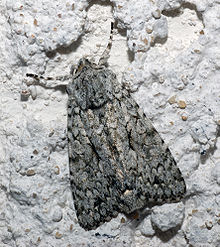| Antitype chi | |
|---|---|

| |
| Scientific classification | |
| Domain: | Eukaryota |
| Kingdom: | Animalia |
| Phylum: | Arthropoda |
| Class: | Insecta |
| Order: | Lepidoptera |
| Superfamily: | Noctuoidea |
| Family: | Noctuidae |
| Genus: | Antitype |
| Species: | A. chi
|
| Binomial name | |
| Antitype chi | |
| Synonyms | |
| |
The grey chi (/kaɪ/; Antitype chi) is a moth of the family Noctuidae. The species was first described by Carl Linnaeus in his 1758 10th edition of Systema Naturae. It is distributed throughout Europe, although it is not present in southern Spain and Greece, as well as northern Fennoscandia. It is also found across the Palearctic including Central Asia, to the Russian Far East but not in Japan.



This species has grey forewings speckled with black markings which vary in intensity (with the female generally more heavily marked than the male). There is usually a bold cross-shaped black mark in the centre of the wing which has been likened to the Greek letter chi (Χ) and gives the species its common name. The hindwings are white in the male, dirty grey in the female.